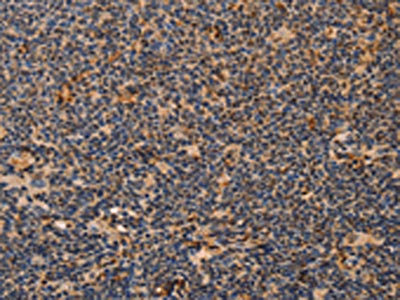
The image on the left is immunohistochemistry of paraffin-embedded Human Lymphoma tissue using CSB-PA658038(MPG Antibody) at dilution 1/40, on the right is treated with fusion protein. (Original magnification: x200)
MPG Antibody
CSB-PA658038
ApplicationsWestern Blot, ELISA, ImmunoHistoChemistry
Product group Antibodies
ReactivityHuman
TargetMPG
Overview
- SupplierCusabio
- Product NameMPG Antibody
- Delivery Days Customer20
- ApplicationsWestern Blot, ELISA, ImmunoHistoChemistry
- CertificationResearch Use Only
- ClonalityPolyclonal
- ConjugateUnconjugated
- Gene ID4350
- Target nameMPG
- Target descriptionN-methylpurine DNA glycosylase
- Target synonymsAAG, ADPG, APNG, CRA36.1, MDG, Mid1, PIG11, PIG16, anpg, DNA-3-methyladenine glycosylase, 3' end of the Mid1 gene, localized 68 kb upstream the humanzeta globin gene on 16p, 3-alkyladenine DNA glycosylase, 3-methyladenine DNA glycosidase, CRA36.1 (3-methyl-adenine DNA glycosylase), N-methylpurine-DNA glycosylase, MPG, proliferation-inducing protein 11, proliferation-inducing protein 16
- HostRabbit
- IsotypeIgG
- Protein IDP29372
- Protein NameDNA-3-methyladenine glycosylase
- Scientific DescriptionMaintenance of DNA sequences is necessary for vertebrates and other life. DNA is under constant stress by a plethora of DNA-damaging agents present in both the environment and within cells. The potentially deleterious effects of DNA lesions in cells are elegantly resolved by sophisticated DNA repair systems, including base excision repair (BER), nucleotide excision repair (NER) and DNA repair methyltransferase (MTase). Methylated bases, such as 3-methyladenine (3MeA) and 7-methylguanine (7MeG) can be formed by agents in the environment and by endogenous cellular processes. Consequently, in the absence of exposure to environmental agents, DNA methylation damage can be incurred on the genomic DNA of normal mammalian cells. DNA N-glycosylases are base excision-repair proteins that locate and cleave damaged bases from DNA as the first step in restoring the sequence.
- ReactivityHuman
- Storage Instruction-20°C or -80°C
- UNSPSC41116161







